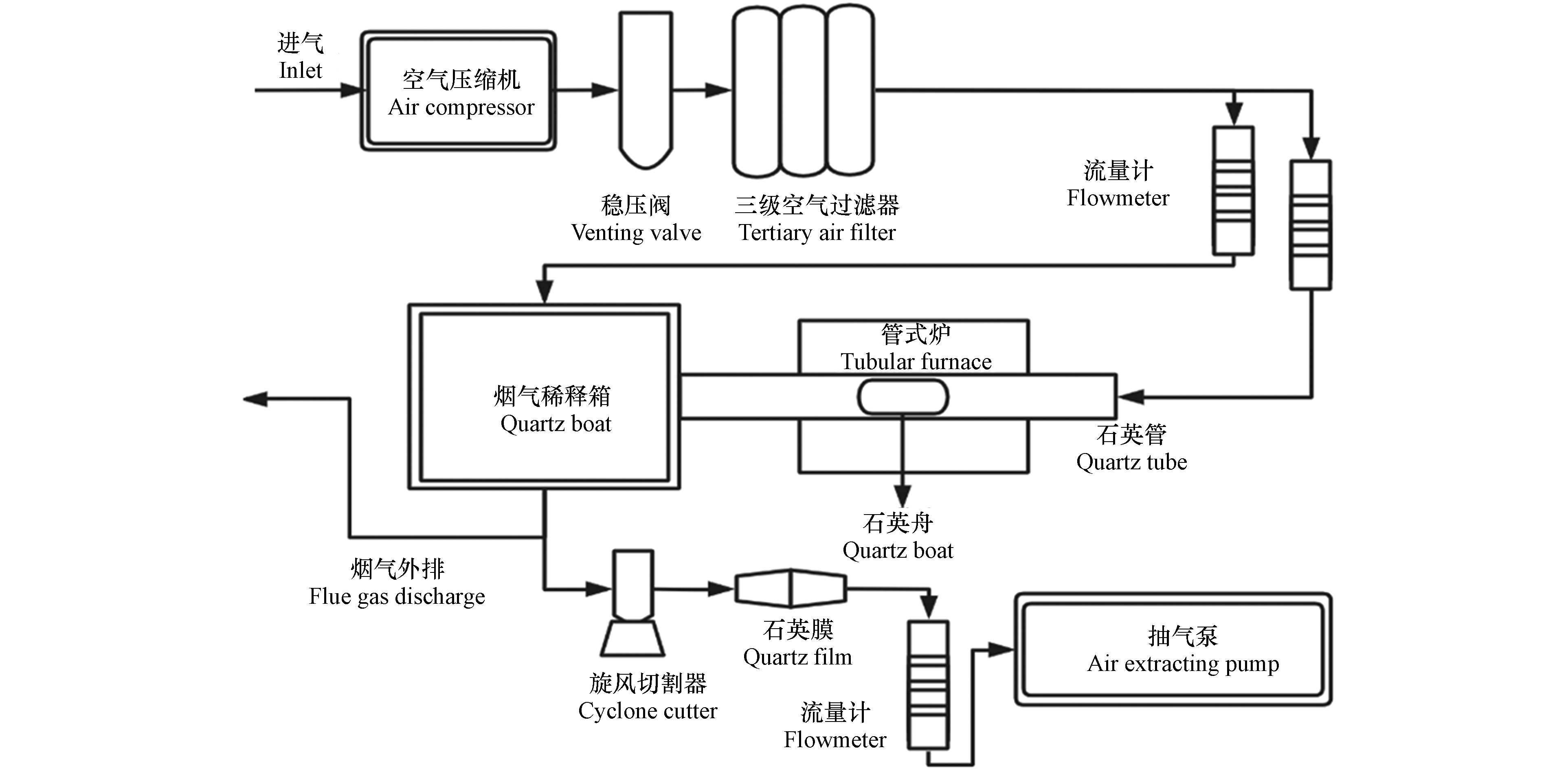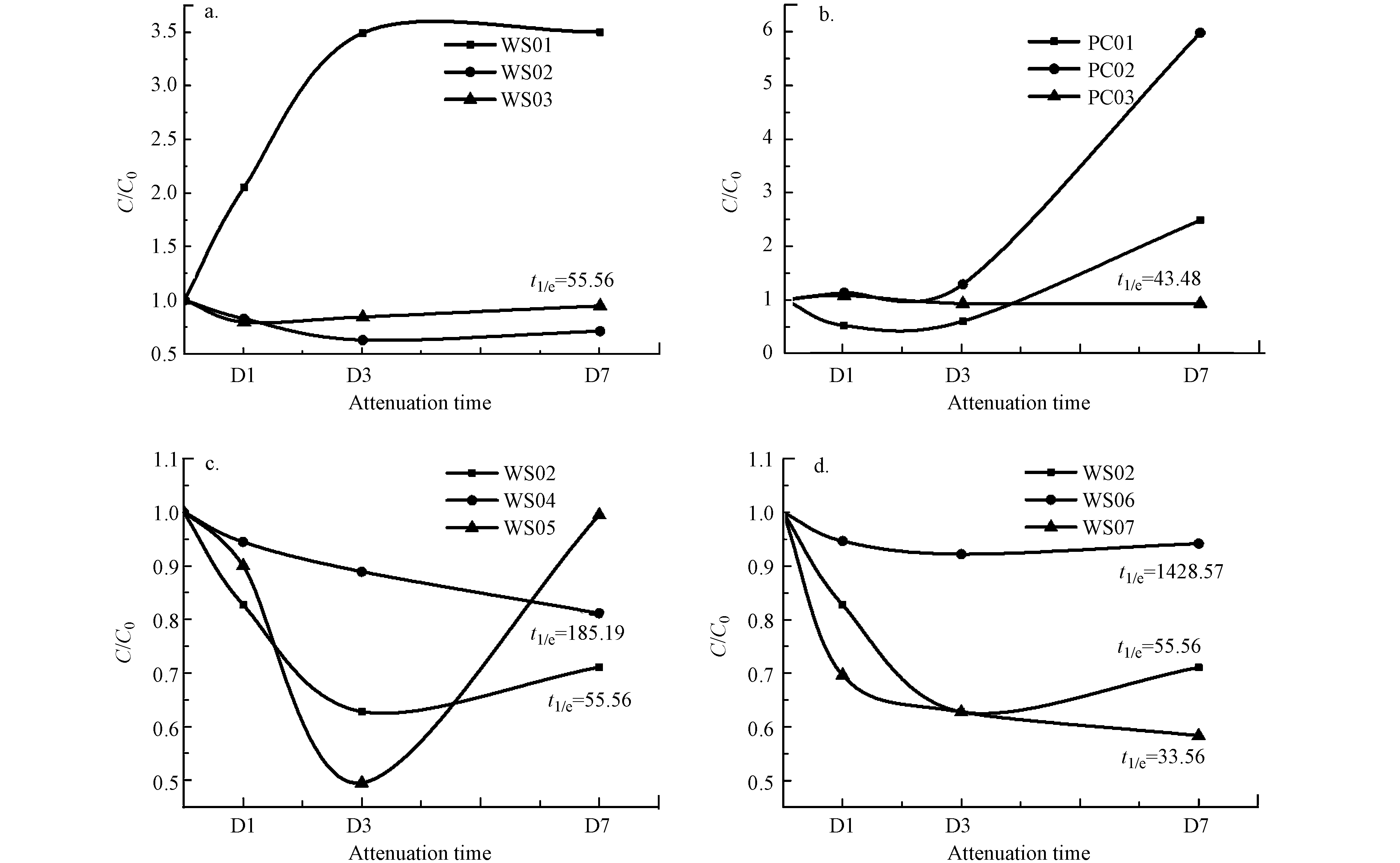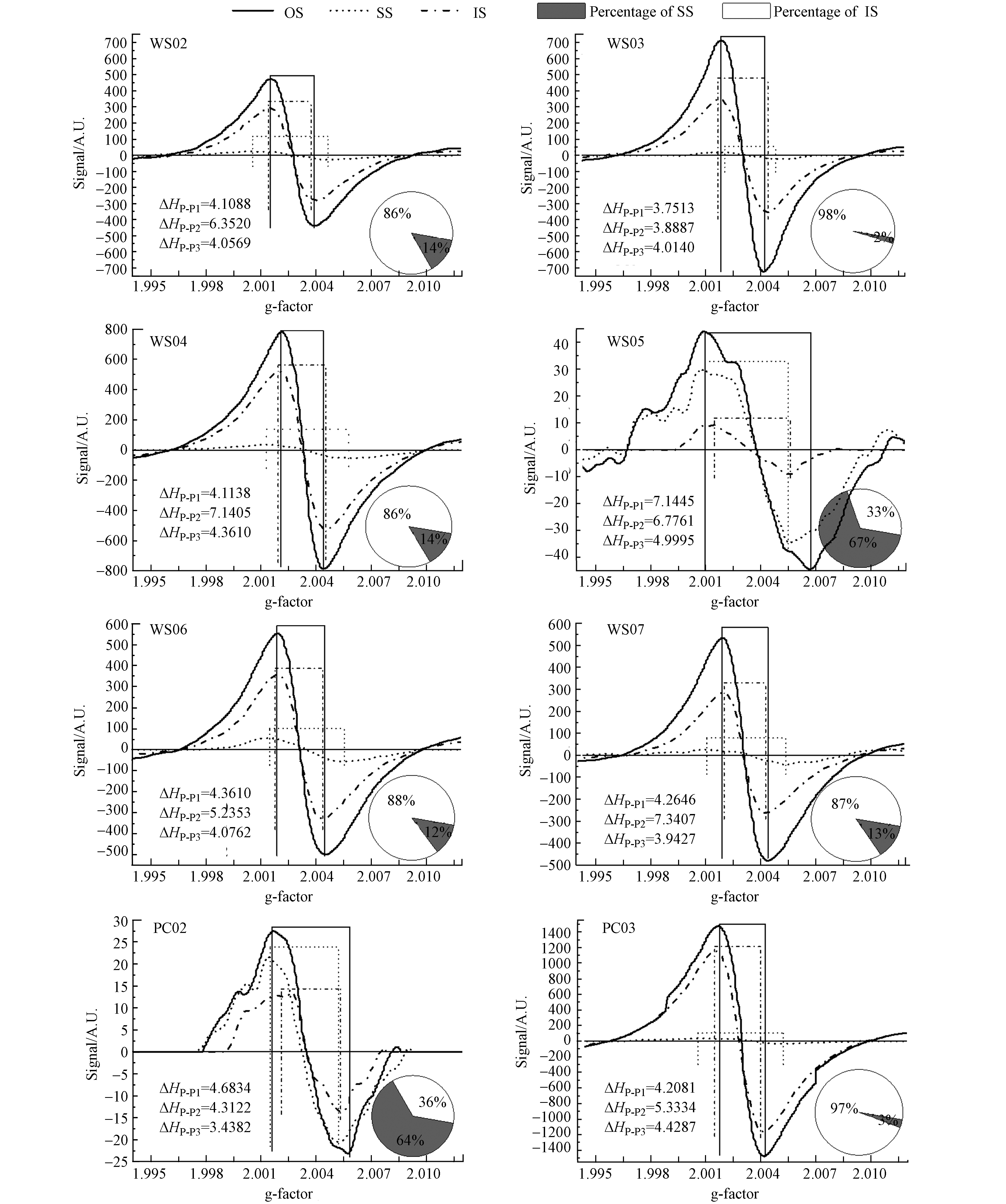-
环境持久性自由基(environmental persistent free radicals,EPFRs)最早被发现于香烟焦油中[1-3]. 近些年随着EPFRs相关研究的不断深入,土壤[4]、飞灰及颗粒物(particulate matter,PM)中也被发现有EPFRs的存在. 目前,国内关于大气中EPFRs的研究多数局限于少数城市[5]及煤燃烧排放EPFRs的相关研究[6-8]. 如,煤燃烧[9],机动车尾气、二次过程和生物质燃烧[10]均是PM中EPFRs的潜在贡献源.
当贡献源之一的生物质生物质不完全燃烧时,会形成表面稳定的金属自由基络合物,比如由α-烷基芳醚和β-烷基芳醚中C—C和C—O键裂解形成自由基[11],此外,木质素、纤维素和血红蛋白等前体物质均可驱动EPFRs的生成. 生物质如松针在300℃下热解初期可产生的EPFRs浓度较低,量级约为1018 spins·g−1,在热解中期、后期均伴有大量EPFRs的产生,热解温度为500℃,热解3 h后排放的EPFRs的浓度最高,量级约为1019 spins·g−1[12]. 其中,300℃以上的高温下生物质热解过程中增加的自由基浓度和结焦量高于煤焦油近百倍[13-14].
另外,生物质燃烧排放的EPFRs可以激活过氧化氢(H2O2)或氧气(O2)生成羟基自由基(·OH)或超氧自由基(·O2–),从而提高有机污染物的降解效率[15]. 我国生物质资源丰富,每年有6亿吨农作物秸秆产生,目前生物质燃烧主要集中在芦苇、树枝、秸秆等[16-18] ,陕西关中地区盛产小麦,每年生产的大量小麦秸秆采用取暖和烹饪燃烧等传统利用方式,是一种潜在的污染[19]. 随着我国农村生活能源的结构变化,小麦秸秆的焚烧日趋严重,对环境带来的污染应受到重视[20]. 因此,了解小麦秸秆燃烧排放的EPFRs污染特征具有重要意义[21].
本研究以分布较广的小麦秸秆和煤粉为试验材料,在不同燃烧温度、燃烧气氛、样品含水率的燃烧条件下燃烧小麦秸秆和煤粉,旨在通过溶剂萃取法分离样品的EPFRs组分并利用电子顺磁共振波谱仪测定其排放烟气颗粒中EPFRs的自旋浓度、种类、线宽(ΔHP-P),对比论证小麦秸秆和煤粉在不同温度下燃烧排放EPFRs的污染特征和衰变特性. 本研究有利于认识典型固体燃料燃烧过程中污染物的转化,了解EPFRs对人体健康的潜在风险,对进一步研究大气污染物的生消机理和控制措施具有重要借鉴意义.
-
小麦秸秆和煤粉燃烧装置及颗粒样品收集装置如图1所示,此系统可以模拟燃料燃烧排放的烟气排入空气中的过程,包含供气系统、反应系统、烟气稀释系统和采样系统. 供气系统由空气压缩机、稳压阀、压缩空气过滤器、流量计组成,反应系统由一根放置在管式炉中直径50 mm的石英管反应器以及放置在石英管中的石英舟组成. 实验过程中,反应气体通过石英管右端进入装置,穿过燃料层,由石英管左端进入烟气稀释系统,通过等速采样吸出,并用PM2.5旋风除尘器(16.7 L·min−1,URG)将PM2.5收集在预先经马弗炉450℃焙烧4 h的石英滤膜(TISSUQUARTZ2500QAT-UP,PALL Life Science)上,以待后续分析.
-
水分(Mad)测定:分别定量称取(1 ± 0.1)g小麦秸秆和煤粉样品,置于(105 ± 2)℃鼓风干燥箱内,于空气流中干燥到质量恒定,根据样品的质量损失计算水分的质量分数;灰分(Aad)测定:定量称取(1 ± 0.1) g小麦秸秆和煤粉样品,平铺在灰皿上,放入马弗炉(SX2-4-10),分别将小麦秸秆与煤粉以一定速度加热到(550 ± 10)℃和(815 ± 10)℃,灰化并灼烧到质量恒定,以残留物占样品的质量分数为样品的灰分;挥发分(Vad)测定:分别定量称取(1 ± 0.1) g小麦秸秆和煤粉样品,放于带盖瓷坩埚中,在(900 ± 10)℃下隔绝空气加热7 min,以减少部分占样品的质量分数减去水分含量为样品的挥发分;固定碳(FCad)计算:固体生物质燃料样品的空气干燥基固定碳,用公式(1)进行计算.
-
小麦秸秆碳(C)、氢(H)、氮(N)元素的质量百分含量通过有机元素分析仪(VARAOELⅢ)测定,分别用wC、wH、wN表示. 称取每份样品2 mg包于专用锡箔纸中,仪器调节到氮气和氧气阀口,设置压强为0.12 MPa和0.2 MPa,氨气流量200 mL·min−1,氧气流量13 — 14 mL·min−1,使用碳氢氮(CHN)模式,燃烧炉1150℃,还原炉850℃时,放入包好的样品,获得测定wC、wH、wN. 采用艾士卡法测定小麦秸秆中硫含量(wS),将固体生物质燃料样品和艾士卡试剂混合灼烧,样品中的硫全部转化为可溶性硫酸盐后,硫酸根离子生成硫酸钡沉淀,根据硫酸钡质量计算固体生物质燃料中全硫含量. 由C、H、N、硫(S)含量计算得出氧(O)含量(wO). 工业分析和元素分析结果如表1所示.
-
将小麦秸秆和煤粉样品在105℃烘箱中干燥至少24 h,确保小麦秸秆和煤粉的初始含水率为0%,后期通过加水使小麦秸秆的含水率增加,从而探索样品含水率是否影响燃烧排放的EPFRs的特征. 精确称量小麦秸秆和煤粉样品2 g于石英舟中,管式炉从室温升高到预设值,为防止小麦秸秆或煤粉提前燃烧,石英舟没有放置在石英管的高温区. 当供气系统开启时,调节供气速率和稀释空气流量,以模拟不同的燃烧条件. 届时将石英舟推入反应区燃烧40 min,同时打开采样系统抽气泵开始采样,调节采样流量为16.7 L·min−1,采样共计70 min. 采集烟气颗粒完成后,将石英滤膜放入膜盒用锡纸包裹保存于 –20℃ 冰箱直至分析. 不同燃烧条件下的烟气颗粒物取样条件信息详见表2.
-
为进一步探索小麦秸秆和煤粉燃烧排放EPFRs的组成,采用溶剂萃取法分离样品中的溶剂可萃取EPFRs和溶剂不可萃取EPFRs,并用MS-5000电子顺磁共振波谱仪(FREIBERG)分析其自旋浓度、g因子以及ΔHP-P. 先用特制钢冲子将附着烟气颗粒物的石英滤膜切割为5 mm × 28 mm的细条,放入12 mL洁净玻璃瓶中,加入1 mL甲醇(色谱纯,Fisher Chemical)和2 mL二氯甲烷(色谱纯,Fisher Chemical)超声30 min,通过聚四氟乙烯(PTFE)滤膜(13 mm,0.22 μm)过滤至4 mL洁净玻璃瓶中,氮吹至近干;其次,用100 μL微量注射器吸取预先配制好的甲醇和二氯甲烷(体积比1:2)溶液少量多次冲洗玻璃瓶,直至溶剂透明无色,将洗液转移至洁净石英纤维滤膜上(5 mm × 28 mm);最后,将滤膜上残余甲醇和二氯甲烷吹干后上机分析.
萃取过程中所用样品瓶均用超纯水洗3次,甲醇洗1次,并用锡纸包裹于马弗炉中450℃下煅烧4 h. 样品处理过程中使用的镊子,玻璃注射器等均用超纯水、甲醇润洗3次,溶液瓶及滴定管等专用物品每次使用时皆用所用试剂润洗3遍,以除去可能的污染物并防止样品的交叉污染.
-
将5 mm × 28 mm的载有滤膜样品的组织池放入电子顺磁共振波谱(electron paramagnetic resonance spectroscopy,EPR)谐振腔内,调好高度进行检测. EPR参数设置为:磁场强度332 —341 mT,检测时间30 s,调制幅度0.20000 mT,检测次数1;微波强度8.0 mW. 在分析样品的EPFRs时,检测前后均用标准物质校准仪器,每次检测均设置空白样品.
通过检测EPR信号的存在时间得到EPFRs的半衰期. 用Matlab开发出基线漂移校正程序去除其它杂质信号干扰(如Fe、Cu等半峰宽较大的EPR信号),并用高斯函数模拟EPFRs信号,提取出g因子、ΔHP-P等特征值,g因子 ≤ 2.0030时,说明样品中EPFRs种类主要是碳中心自由基,如芳烃类自由基;g因子 ≥ 2.0040时,说明样品中EPFRs主要是氧中心自由基,如半醌类自由基[22];g因子在2.0030—2.0040时,样品中EPFRs主要是含氧官能团的碳中心自由基,如苯氧基[23],两个样品的线宽相近时表示样品可能具有相同结构的EPFRs[24].
样品中EPFRs大气浓度 SEPFRs (spins·m−3)的计算公式如下:
式中,F为形状校正系数,约为1.06[18],代表滤膜样品和铬标准品的平均响应信号比值;SCr3+代表铬标总自旋量,为2.18×1018 spins·m−3 [6],铬标为德国FREIBERG公司的E1707- 0005,内径3.0 mm,外径4.0 mm;AEPFRs和ACr3+分别代表样品和铬标准品EPR吸收曲线中积分曲线的面积,ACr3+为1.46 × 107,AEPFRs用信号强度E(A.U.)与线宽ΔHP-P(G)平方之积表示[25-26],即:
-
初次分析后将样品用锡纸包裹放入样品袋中,常温下观察. 在1、3、7 d后再次分析样品中EPFRs的g因子ΔHP-P及自旋浓度的变化,根据公式(4)和公式(5)计算样品的半衰期.
式中,C0是指初始时刻(t = 0)时EPFRs浓度;C是衰变后的EPFRs浓度;t为衰变时间;t1/e为半衰期;k为衰减速率常数,由自由基浓度比(C/C0)的对数与时间的斜率得出[25].
-
为评价不同燃烧条件下小麦秸秆和煤粉中EPFRs对居民潜在健康风险的大小,用当量香烟数代表EPFRs暴露量. 通过公式(6)将成年人每天吸入体内的PM2.5中EPFRs的浓度换算成香烟数:
式中,Ncig是香烟数量,支;CEPFRs是EPFRs 的体积自旋浓度,spins·m−3;V是成年男性每天呼吸的空气量,20 m3·d-1[27-29];RCcig是香烟焦油中自由基的浓度,4.75×1016 spins·g-1[30-32];Ctar是每支香烟的焦油量,0.013 g·cig-1[33-36].
-
小麦秸秆和煤粉的原始样品在不同燃烧温度(300、500、700℃)、燃烧气氛(空气通入量2、4 L·min−1,氮气通入量4 L·min−1)、样品含水率(0%、8%、27%)下燃烧排放EPFRs种类和浓度不同. 样品的电子顺磁共振波谱如图2所示.
WS01、WS05、PC01、PC02样品中EPFRs的g因子分别为2.0042、2.0041、2.0040、2.0041,样品燃烧排放的EPFRs类型主要是氧中心自由基,检测到的EPFRs信号较弱,EPFRs的浓度为1014和1015量级. 其中,WS01样品燃烧排放的EPFRs浓度为1.33 × 1014 spins·m−3,与西安市大气中EPFRs浓度相近(2.16 × 1014 spins·m−3),相当于每人每天吸入体内4支香烟[37]. 而WS02、WS03、WS04样品的g因子均为2.0034,WS06、WS07和PC03样品的g因子分别为2.0035、2.0035和2.0032,EPFRs的类型主要是含氧官能团的碳中心自由基,检测到的EPFRs信号较强,EPFRs浓度为1016量级,相当于吸入体内470—1500支香烟.
小麦秸秆样品WS01、WS02、WS03和煤粉样品PC01、PC02、PC03排放EPFRs的ΔHP-P较接近,在4.00 G上下浮动,可能具有相同的结构,随着温度的升高,ΔHP-P均呈现出先增大后减小的趋势. 结合EPFRs的浓度及g因子变化得出,EPFRs的浓度随着温度的升高而增加,小麦秸秆与煤粉在不同温度下燃烧排放EPFRs的g因子转变方式一致,由氧中心自由基转变为含氧官能团的碳中心自由基,不同之处在于小麦秸秆于500℃时的燃烧已经完成这一转化,煤粉在700℃燃烧时才完成这一转化,煤粉燃烧需要更高的温度(T ≥ 700℃)来使有机分子键断裂产生自由基,300℃和500℃时样品不能完全燃烧,断键较少,剩余部分为黑炭类物质,700℃时燃烧基本完全,剩余部分为灰分,温度越高,能量越高,燃烧更充分,断键较多,从而形成更多自由基[38]. Qin等[39]的研究也表明生物炭中的g因子在2.0042—2.0052,燃烧排放的EPFRs为以氧为中心的自由基,随着热解温度由300℃到600℃的升高,g因子明显降低,EPFRs浓度增加,可能是由于C—O键的断裂或O与断裂的C—C键的结合,导致以氧为中心的EPFRs的形成,从而导致EPFRs浓度的急剧增加. 样品WS02、WS04、WS05燃烧排放EPFRs的线宽ΔHP-P相差较大,分别是4.1008 G、4.1138 G和7.1445 G,结合其g因子及浓度的转变,说明氧气含量的升高可驱使氧中心自由基转化为含氧官能团的碳中心自由基,自由基浓度升高,EPFRs结构发生变化. 样品WS02、WS06、WS07的EPR谱图相似,ΔHP-P变化相对较小,均在4.20 G上下浮动,g因子种类和浓度也未发生明显变化,说明不同含水率样品燃烧排放的EPFRs较为稳定,是同一化学物质结构体.
温度和气氛对小麦秸秆样品燃烧排放的EPFRs种类、结构及浓度的影响较大,但样品含水率的变化对排放的EPFRs影响较小. 低温低氧或无氧条件下,小麦秸秆和煤粉燃烧以阴燃或热解为主,排放的EPFRs主要为氧中心自由基;随着温度和空气通入量的增加,小麦秸秆和煤粉逐渐开始燃烧,氧中心自由基逐步转化为含氧官能团的碳中心自由基. 自由基浓度呈显著上升趋势.
-
Gehling和Dellinger[6]在2013年的研究仅表明EPFRs有快速衰变型、缓慢衰变型和不衰变型,并未定量小麦秸秆燃烧排放的EPFRs的衰变特性. 为获得典型固体燃料在不同燃烧条件下排放EPFRs的衰变特征,在初次实验的1、3、7 d分别对原始样品进行EPR检测,计算得到各样品浓度、g因子及ΔHP-P参数见表3,EPFRs自旋浓度变化及半衰期详见图3.
7 d内,WS01、PC01样品燃烧排放EPFRs的g因子由 ≥ 2.0040,转变为2.0030—2.0040后又转变为 ≥ 2.0040,EPFRs种类由氧中心自由基转变为含氧官能团的碳中心自由基后又转变为氧中心自由基,可能是由于芳香化合物(如多环芳烃)被酚类氧化而形成半醌基造成[40];样品WS05、PC02燃烧排放EPFRs的g因子由 ≥ 2.0040转变为2.0030—2.0040,EPFRs种类由氧中心自由基转变为含氧官能团的碳中心自由基;样品WS02、WS03、WS04、WS06、WS07及PC03燃烧排放EPFRs的g因子始终在2.0030—2.0040,变化为 ± 0.0001,EPFRs始终为含氧官能团的碳中心自由基.
根据样品自由基浓度比(C/C0)的对数与时间的斜率折算半衰期,样品WS01、WS03、WS05、PC01和PC02条件下,燃烧排放EPFRs浓度变化与时间的斜率为正值,呈增长趋势,衰变模式为非衰变型,如300℃条件下小麦秸秆燃烧排放EPFRs浓度的增长可能是由于芳香化合物(如多环芳烃)被酚类或醌类化合物氧化而形成半醌基或苯氧基造成;样品WS02、WS04、WS07和PC03燃烧排放的EPFRs浓度在7 d内分别下降了约37%、48%、42%和15%,半衰期分别为56 d、185 d、34 d和43 d,是快速衰变型;样品WS06燃烧排放的EPFRs浓度在7 d内下降了5%—7%,半衰期为1429 d,为缓慢衰变型. 陈庆彩等[41]研究发现,蒿和木材燃烧所排放的EPFRs在1 —7 d内下降了约15%—20%,燃烧葡萄枝排放的PM2.5样品中的EPFRs衰减最大,在1 —7 d内下降了25%—30%,煤和玉米秸秆相对稳定,EPFRs的在180 d内仅下降了15%—20%,其中,玉米秸秆排放的慢衰减型EPFRs的平均1/e寿命为1346 d,这与WS06燃烧排放的EPFRs的半衰期类似.
WS01样品燃烧排放的EPFRs的ΔHP-P由2.4553 G变化到4.2649 G,PC01样品燃烧排放EPFRs的线宽ΔHP-P由3.6869 G变为5.7394 G,WS05样品燃烧排放EPFRs的ΔHP-P由7.1445 G变为5.6273 G 后又变为7.1039 G,PC02样品由4.6834 G变为5.2362 G又变为4.6011 G,说明随着衰减时间的增加,样品的化学结构发生部分变化;WS02、WS03、WS04、WS06、WS07、PC03样品的ΔHP-P无明显变化,分别在4.10 、3.66、4.06、4.39 、4.19、4.18 G浮动,表明7 d内燃烧排放的EPFRs有相似的化学结构.
低温低氧或无氧条件下,小麦秸秆和煤粉燃烧以阴燃或热解为主,燃烧排放的EPFRs的g因子和ΔHP-P不稳定,由氧中心自由基转变为含氧官能团的碳中心自由基再次转变为氧中心自由基,EPFRs浓度小幅度增长,为非衰变型;随着温度和空气通入量的增加,小麦秸秆和煤粉逐渐开始燃烧,排放的EPFRs的g因子和ΔHP-P较稳定,种类和结构短时间内不发生转化,随着空气通入量的升高,样品中EPFRs浓度衰减越少,半衰期越长;当温度和空气量足够,小麦秸秆和煤粉可达到完全燃烧,EPFRs浓度衰减迅速,半衰期较短,分别为56 d和43 d,为快速衰变型,含水率的变化对小麦秸秆燃烧排放EPFRs衰变类型的影响无规律性.
-
用甲醇和二氯甲烷对原始样品进行萃取得到溶剂可萃取样品,萃取后样品各组分EPR谱图如图4所示, OS表示原始样品,SS为溶剂可萃取部分, IS为溶剂不可萃取部分. 萃取实验过程中300℃时原始样品信号较弱,所得样品无规律性,溶剂可萃取组分反而超过萃取前的样品,因此萃取分析中只对样品在500℃和700℃下进行分析.
WS02、WS03、WS04、WS06、WS07及PC03燃烧排放的烟气中,IS-EPFRs的占比在86%—98%,g因子均在2.0030—2.0040,是含氧官能团的碳中心自由基,ΔHP-P与原始样品的ΔHP-P接近,化学结构类似;SS-EPFRs的占比介于2%—14%,ΔHP-P与原始样品差距较大,EPFRs的化学结构显著改变;样品含水率基本不影响IS-EPFRs和SS-EPFRs的百分占比,均在87%. WS05和PC02燃烧排放的SS-EPFRs的占比分别为66.56%和64.27%,g因子均在 2.0040 以上,为氧中心自由基,ΔHP-P与原始样品接近,化学结构类似;IS-EPFRs的占比约为原始样品的1/3,g因子和ΔHP-P均有较大变化.
低温低氧或无氧条件下,小麦秸秆和煤粉燃烧以阴燃或热解为主,排放的EPFRs主要为氧中心自由基,主要为有机溶剂可萃取的EPFRs;随着温度和空气通入量的增加,小麦秸秆和煤粉逐渐开始燃烧,氧中心自由基逐步转化为含氧官能团的碳中心自由基,主要为溶剂不可萃取的EPFRs,当温度和空气量足够,小麦秸秆和煤粉可达到完全燃烧,溶剂不可萃取的EPFRs部分可达97.01%,该结果与陈庆彩等[42]对实际大气PM2.5中EPFRs的研究结果基本一致.
-
为研究典型固体燃料燃烧排放的环境持久性自由基(EPFRs)的污染特征,本研究选取小麦秸秆和煤粉为研究对象,利用MS-5000电子顺磁共振谱仪,探究燃烧温度、燃烧气氛和样品含水率对小麦秸秆和煤粉燃烧后排放的EPFRs的自旋浓度、g因子、ΔHP-P等特性的影响,通过衰减和萃取进行污染特征的补充,研究得到以下结论:
(1)燃烧温度和空气通入量的增加驱使小麦秸秆和煤粉燃烧排放EPFRs由氧中心自由基转为含氧官能团的碳中心自由基,导致EPFRs自旋浓度显著增加;同等燃烧条件下,单位质量的小麦秸秆燃烧排放的烟气中EPFRs的含量低于单位质量的煤粉燃烧;样品中含水率的变化对烟气中EPFRs的含量和种类基本无影响.
(2)7 d时间内,小麦秸秆和煤粉在低温低氧或无氧条件下燃烧排放的EPFRs为非衰变型;当有氧存在时,EPFRs转变为可衰变型,随着燃烧温度和空气通入量的增加,半衰期逐步增加,为43 d—185 d;含水率的变化对EPFRs的化学稳定性及半衰期的影响无规律性.
(3)萃取实验表明,燃烧温度和空气通入量的变化会改变燃料燃烧排放的EPFRs的溶剂可萃取性,燃烧越充分,甲醇和二氯甲烷溶剂不可萃取EPFRs部分的占比越高低,达86%—98%.
固体燃料燃烧排放的颗粒物中的EPFRs是一类新型环境风险物质,目前学术界对其的认识及研究尚不全面. 本文对于陕西关中地区盛产的小麦秸秆和煤粉进行研究,由于实验条件和样品来源受限,本文存在一定待研究的盲点. 在未来的研究中可以从以下几个方面入手:(1)除了燃料燃烧后的1、3、7 d外,继续研究更长时间后EPFRs的浓度和g因子等数据的变化,可以更好地理解燃料燃烧排放颗粒物中EPFRs的衰变特性;(2)继续对其他固体燃料,如玉米、水稻秸秆进行研究,进一步得出固体燃料燃烧排放EPFRs的特征,为大气污染分析提供更多的科学依据.
典型固体燃料燃烧排放环境持久性自由基的特征
Characteristics of environmental persistent free radicals emitted by typical solid fuel combustion
-
摘要: 为研究典型固体燃料燃烧排放环境持久性自由基(EPFRs)的污染特征,本文以小麦秸秆和煤粉为研究对象,利用自制的燃料燃烧和颗粒物样品收集装置获得小麦秸秆和煤粉在不同燃烧条件下排放的烟气颗粒样品,基于电子顺磁共振波谱技术(EPR)分别确定EPFRs在第0、1、3、7 天的自旋浓度、g因子、ΔHP-P,通过萃取实验确定EPFRs可被甲醇和二氯甲烷所萃取的量,以获得其污染、衰变特性. 结果表明,低温低氧或无氧条件下,小麦秸秆和煤粉燃烧以阴燃或热解为主,排放的EPFRs主要为氧中心自由基,属于非衰变型,有机溶剂可萃取部分可达67%;随着温度和空气通入量的增加,小麦秸秆和煤粉逐渐燃烧,排放的EPFRs浓度增加,由氧中心自由基逐步转化为含氧官能团的碳中心自由基,衰变缓慢,溶剂可萃取的EPFRs占比仅有2.14%;当温度和空气量足够,小麦秸秆和煤粉完全燃烧,半衰期分别为56 d和43 d,为快速衰变型,溶剂不可萃取的EPFRs部分高达97.01%. 温度和空气量对小麦秸秆和煤粉燃烧排放的EPFRs的种类、结构及衰减影响大,而样品含水率无显著影响.Abstract: To explore the characteristics of environmental persistent free radicals (EPFRs) emitted by the combustion of typical solid fuels (i.e., the wheat straw and pulverized coal), a self-made device for fuel combustion and particle sample collection was used to obtain the flue gas samples under different combustion conditions. Based on electron paramagnetic resonance spectroscopy (EPR), the spin concentration, g factor and ΔHP-P of EPFRs on the 0th, 1st, 3rd, and 7th day were determined respectively, while the percentage of EPFRs extracted by the methanol (MeOH) and methylene chloride (DCM) were measured to obtain their pollution and attenuation characteristics. Results showed that under low temperature, hypoxia or anaerobic conditions, the combustion of wheat straw and pulverized coal was mainly smoldering or pyrolysis, and the emitted EPFRs were mainly non-decaying oxygen-centered radicals, about 67% of which were extractable. With the increase of temperature and air intake, wheat straw and pulverized coal were gradually burned, leading to a increase of the spin concentration of the emitted EPFRs. Meanwhile, the oxygen-centered radicals gradually converted into slow-decaying carbon-centered free radicals with oxygen-containing functional groups, only 2.14% of which were extractable. When the temperature and air volume were sufficient, wheat straw and pulverized coal were completely burned with half-lives of 56 d and 43 d, respectively, which were fast decay types, and the fraction of EPFRs that could not be extracted by both MeOH and DCM could reach 97.01%. As a conclusion, the characteristics (i.e. type, structure, attenuation) of EPFRs emitted from wheat straw and pulverized coal combustion were significantly influenced by temperature and air supply, while the moisture content of the samples had no significant influence.
-

-
图 2 (a)不同燃烧温度原始小麦秸秆样品、(b)不同燃烧温度原始煤粉样品、(c)不同燃烧气氛原始小麦秸秆样品、(d)不同样品含水率原始小麦秸秆样品排放EPFRs的电子顺磁共振谱图
Figure 2. Electron Paramagnetic Resonance spectroscopy of EPFRs emissions from (a) original wheat straw samples with different combustion temperatures, (b) original pulverized coal samples with different combustion temperatures, (c) original wheat straw samples with different combustion atmospheres, (d) original wheat straw samples with different sample moisture contents
图 3 (a)不同燃烧温度小麦秸秆样品、(b)不同燃烧温度煤粉样品、(c)不同燃烧气氛小麦秸秆样品、(d)不同样品含水率小麦秸秆样品衰减过程中样品排放EPFRs浓度变化及半衰期
Figure 3. Variation of EPFRs concentration and half-life of samples during attenuation of (a) wheat straw samples with different combustion temperatures, (b) pulverized coal samples with different combustion temperatures, (c) wheat straw samples with different combustion atmospheres, (d) wheat straw samples with different sample moisture content
表 1 工业分析和元素分析
Table 1. Industrial Analysis and Element Analysis
样品
Sample工业分析 /%
Industrial analysis元素分析 /%
Element analysisMad Aad Vad FCad wC wH wO wN wS 小麦秸秆 8.2 8.6 66.8 16.4 21.19 3.48 57.72 0.81 0.27 煤粉 7.7 11.8 34.2 46.3 58.93 4.09 34.86 1.14 0.98 表 2 不同燃烧条件下烟气颗粒的取样
Table 2. Sampling of flue gas particles under different combustion conditions
样品编号
ID样品量/ g
Mass燃烧温度/ ℃
Comb temp样品含水率/ %
Moisture供气速度/ (L·min−1)
Air supply烟气稀释空气通入量/ (m3·h−1)
Dilution air supply烟气稀释比
Flue gas dilution ratioWS01 2 300 0 空气 2 2 16.7 WS02 2 500 0 空气 2 2 16.7 WS03 2 700 0 空气 2 2 16.7 WS04 2 500 0 空气 4 2 8.3 WS05 2 500 0 氮气 4 2 8.3 WS06 2 500 8 空气 2 2 16.7 WS07 2 500 27 空气 2 2 16.7 PC01 2 300 0 空气 4 4 16.7 PC02 2 500 0 空气 4 4 16.7 PC03 2 700 0 空气 4 4 16.7 注:WS指小麦秸秆;PC指煤粉,烟气稀释比是烟气稀释系统空气通入量与供气系统空气通入量之比,即两个流量计流量之比,Comb temp代表燃烧温度. Note: WS refers to wheat straw; PC refers to pulverized coal, and the flue gas dilution ratio is the ratio of the air inlet volume of the flue gas dilution system to the air inlet volume of the gas supply system, that is, the ratio of the flow of the two flow meters. Comb temp refers to Combustion temperature. 表 3 不同燃烧条件下衰减样品中EPFRs的参数
Table 3. Parameters of EPFRs in attenuation samples under different combustion conditions
样品
IDD0 D1 D3 D7 浓度/(spins·m−3)
Conc.g因子
g-factor线宽
/G
ΔHP-P浓度/(spins·m−3)
Conc.g因子
g-factor线宽
/G
ΔHP-P浓度/(spins·m−3)
Conc.g因子
g-factor线宽
/G
ΔHP-P浓度/(spins·m−3)
Conc.g因子
g-factor线宽
/G
ΔHP-PWS01 1.33×1014 2.0042 2.4553 2.73×1014 2.0037 4.3641 4.64×1014 2.0038 4.3392 4.65×1014 2.0040 4.2649 WS02 1.45×1016 2.0034 4.1008 1.20×1016 2.0034 4.0904 9.10×1015 2.0034 4.0803 1.03×1016 2.0033 4.1353 WS03 2.49×1016 2.0034 3.7513 1.98×1016 2.0033 3.6642 2.10×1016 2.0035 3.6222 2.36×1016 2.0034 3.6336 WS04 2.70×1016 2.0033 4.1138 2.55×1016 2.0033 4.1359 1.40×1016 2.0034 3.8896 2.19×1016 2.0032 4.0876 WS05 3.84×1015 2.0041 7.1445 3.44×1015 2.0037 5.7628 1.90×1015 2.0037 5.6273 3.82×1015 2.0037 7.1039 WS06 2.05×1016 2.0035 4.3675 1.94×1016 2.0035 4.3652 1.89×1016 2.0035 4.4192 1.93×1016 2.0034 4.4295 WS07 2.04×1016 2.0035 4.2646 1.42×1016 2.0035 4.1652 1.28×1016 2.0035 4.1624 1.19×1016 2.0035 4.1855 PC01 3.46×1014 2.0040 3.6869 1.79×1014 2.0034 3.6135 2.08×1014 2.0041 3.4149 8.59×1014 2.0044 5.7394 PC02 1.04×1015 2.0041 4.6834 1.18×1015 2.0039 4.5787 1.34×1015 2.0038 5.2362 6.22×1014 2.0037 4.6011 PC03 4.74×1016 2.0032 4.2081 5.32×1016 2.0033 4.2081 4.55×1016 2.0032 4.1600 4.55×1016 2.0032 4.1610 注:D0指衰变实验开始的当天,D1指衰变实验开始的当天,Conc. 指EPFRs的体积自旋浓度. Note: D0 refers to the day when the attenuation experiment begins, D1 refers to the first day of attenuation experiment. Conc. refers to the volume spin concentration of EPFRs. -
[1] WANG P, PAN B, LI H, et al. The overlooked occurrence of environmentally persistent free radicals in an area with low-rank coal burning, Xuanwei, China [J]. Environmental Science & Technology, 2018, 52(3): 1054-1061. [2] PRÜSS-USTÜN A, BONJOUR S, CORVALÁN C. The impact of the environment on health by country: A meta-synthesis [J]. Environmental Health:a Global Access Science Source, 2008, 7: 7. [3] INGRAM D J E, TAPLEY J G, JACKSON R, et al. Paramagnetic resonance in carbonaceous solids [J]. Nature, 1954, 174(4434): 797-798. doi: 10.1038/174797a0 [4] FELD-COOK E E, BOVENKAMP-LANGLOIS L, LOMNICKI S M. Effect of particulate matter mineral composition on environmentally persistent free radical (EPFR) formation [J]. Environmental Science & Technology, 2017, 51(18): 10396-10402. [5] CHEN Q C, SUN H Y, MU Z, et al. Characteristics of environmentally persistent free radicals in PM2.5: Concentrations, species and sources in Xi'an, Northwestern China [J]. Environmental Pollution, 2019, 247: 18-26. doi: 10.1016/j.envpol.2019.01.015 [6] GEHLING W, DELLINGER B. Environmentally persistent free radicals and their lifetimes in PM2.5 [J]. Environmental Science & Technology, 2013, 47(15): 8172-8178. [7] PARK J, PARK E H, SCHAUER J J, et al. Reactive oxygen species (ROS) activity of ambient fine particles (PM2.5) measured in Seoul, Korea [J]. Environment International, 2018, 117: 276-283. doi: 10.1016/j.envint.2018.05.018 [8] YANG L L, LIU G R, ZHENG M H, et al. Highly elevated levels and particle-size distributions of environmentally persistent free radicals in haze-associated atmosphere [J]. Environmental Science & Technology, 2017, 51(14): 7936-7944. [9] LYONS M J, SPENCE J B. Environmental free radicals [J]. British Journal of Cancer, 1960, 14(4): 703-708. doi: 10.1038/bjc.1960.79 [10] ARANGIO A M, TONG H J, SOCORRO J, et al. Quantification of environmentally persistent free radicals and reactive oxygen species in atmospheric aerosol particles [J]. Atmospheric Chemistry and Physics, 2016, 16(20): 13105-13119. doi: 10.5194/acp-16-13105-2016 [11] CHEN Q C, WANG M M, WANG Y Q, et al. Rapid determination of environmentally persistent free radicals (EPFRs) in atmospheric particles with a quartz sheet-based approach using electron paramagnetic resonance (EPR) spectroscopy [J]. Atmospheric Environment, 2018, 184: 140-145. doi: 10.1016/j.atmosenv.2018.04.046 [12] 曹迪. 含环境持久性自由基生物炭的制备及其对斜生栅藻的毒性研究[D]. 大连: 大连理工大学, 2017. CAO D. Study on the preparation of environmental persistent free radicals (EPFRs) containing biochar and its toxicity on Scenedesmus obliquus[D]. Dalian: Dalian University of Technology, 2017(in Chinese).
[13] TRUONG H, LOMNICKI S, DELLINGER B. Potential for misidentification of environmentally persistent free radicals as molecular pollutants in particulate matter [J]. Environmental Science & Technology, 2010, 44(6): 1933-1939. [14] 何文静. 煤和生物质热解及煤溶剂抽提过程中自由基反应行为研究[D]. 北京: 北京化工大学, 2015. HE W J. Behaviors of radicals in the processes of pvrolvsis of coals and biomass and solvent extraction of coals[D]. Beijing: Beijing University of Chemical Technology, 2015(in Chinese).
[15] DELA CRUZ A L, GEHLING W, LOMNICKI S, et al. Detection of environmentally persistent free radicals at a superfund wood treating site [J]. Environmental Science & Technology, 2011, 45(15): 6356-6365. [16] 袁静. 农作物秸秆燃烧排放PM2.5中有机物的研究[D]. 南京: 南京信息工程大学, 2011. YUAN J. The research of particulate organic matters emitted from cereal straws combustion[D]. Nanjing: Nanjing University of Information Science & Technology, 2011(in Chinese).
[17] TIAN L W, KOSHLAND C P, YANO J, et al. Carbon-centered free radicals in particulate matter emissions from wood and coal combustion [J]. Energy & Fuels:an American Chemical Society Journal, 2009, 23(5): 2523-2526. [18] QIAN R Z, ZHANG S M, PENG C, et al. Characteristics and potential exposure risks of environmentally persistent free radicals in PM2.5 in the Three Gorges Reservoir area, Southwestern China [J]. Chemosphere, 2020, 252: 126425. doi: 10.1016/j.chemosphere.2020.126425 [19] 胡炳涛. 陕西关中麦草秸秆热解特性及其动力学研究[D]. 西安: 陕西科技大学, 2016. HU B T. Study on the pyrolytic characteristics and kinetics of wheat straw from Guanzhong plain of Shaanxi[D]. Xi'an: Shaanxi University of Science & Technology, 2016(in Chinese).
[20] LIEKE T, ZHANG X C, STEINBERG C E W, et al. Overlooked risks of biochars: Persistent free radicals trigger neurotoxicity in Caenorhabditis elegans [J]. Environmental Science & Technology, 2018, 52(14): 7981-7987. [21] 贺开来, 李娅绮, 徐红梅, 等. 家用燃料燃烧排放PM2.5的特征及其对肺功能的影响: 以陕西蓝田县为例 [J]. 环境化学, 2020, 39(2): 552-565. doi: 10.7524/j.issn.0254-6108.2019032301 HE K L, LI Y Q, XU H M, et al. Characteristics of PM2.5 emitted from domestic fuel combustion and its effect on lung function: A case study in Lantian County, Shaanxi, China [J]. Environmental Chemistry, 2020, 39(2): 552-565(in Chinese). doi: 10.7524/j.issn.0254-6108.2019032301
[22] WITWICKI M, JERZYKIEWICZ M, OZAROWSKI A. Understanding natural semiquinone radicals - Multifrequency EPR and relativistic DFT studies of the structure of Hg(II) complexes [J]. Chemosphere, 2015, 119: 479-484. doi: 10.1016/j.chemosphere.2014.07.047 [23] DELA CRUZ A L, COOK R L, LOMNICKI S M, et al. Effect of low temperature thermal treatment on soils contaminated with pentachlorophenol and environmentally persistent free radicals [J]. Environmental Science & Technology, 2012, 46(11): 5971-5978. [24] 钱若芷. 三峡库区典型城区PM2.5化学组成及持久性自由基的健康影响研究[D]. 重庆: 重庆三峡学院, 2020. QIAN R Z. Study on the chemical composition of PM2.5 and the health effects of persistent free radicals in typical urban areas of the Three Gorges Reservoir Area[D]. Chongqing: Chongqing Three Gorges University, 2020(in Chinese).
[25] KHACHATRYAN L, VEJERANO E, LOMNICKI S, et al. Environmentally persistent free radicals (EPFRs). 1. generation of reactive oxygen species in aqueous solutions [J]. Environmental Science & Technology, 2011, 45(19): 8559-8566. [26] CHEN Q C, WANG M M, SUN H Y, et al. Enhanced health risks from exposure to environmentally persistent free radicals and the oxidative stress of PM2.5 from Asian dust storms in Erenhot, Zhangbei and Jinan, China [J]. Environment International, 2018, 121: 260-268. doi: 10.1016/j.envint.2018.09.012 [27] 刘程成. 环境健康风险评估中土壤摄入、呼吸和皮肤暴露参数研究[D]. 常州: 常州大学, 2021. LIU C C. Soil intake, respiration, and skin exposure parameters in environmental health risk assessment[D]. Changzhou: Changzhou University, 2021(in Chinese).
[28] PRYOR W A. Oxy-radicals and related species: Their formation, lifetimes, and reactions [J]. Annual Review of Physiology, 1986, 48(1): 657-667. doi: 10.1146/annurev.ph.48.030186.003301 [29] VEJERANO E P, RAO G Y, KHACHATRYAN L, et al. Environmentally persistent free radicals: Insights on a new class of pollutants [J]. Environmental Science & Technology, 2018, 52(5): 2468-2481. [30] GEHLING W, KHACHATRYAN L, DELLINGER B. Hydroxyl radical generation from environmentally persistent free radicals (EPFRs) in PM2.5 [J]. Environmental Science & Technology, 2014, 48(8): 4266-4272. [31] BAUM S L, ANDERSON I G M, BAKER R R, et al. Electron spin resonance and spin trap investigation of free radicals in cigarette smoke: Development of a quantification procedure [J]. Analytica Chimica Acta, 2003, 481(1): 1-13. doi: 10.1016/S0003-2670(03)00078-3 [32] US EPA. Recommendations for and documentation of biological values for use in risk assessment[R]. EPA/600/6-87/008, 1988. [33] 阮光辉. 香烟和燃香燃烧排放系颗粒物中离子和碳组分特征研究[D]. 上海: 华东理工大学, 2020. RUAN G H. Study on the characteristics of ionic and carbonaceous components in fine particles emitted from cigarettes and incense burning[D]. Shanghai: East China University of Science and Technology, 2020(in Chinese).
[34] BLAKLEY R L, HENRY D D, SMITH C J. Lack of correlation between cigarette mainstream smoke particulate phase radicals and hydroquinone yield [J]. Food and Chemical Toxicology, 2001, 39(4): 401-406. doi: 10.1016/S0278-6915(00)00144-7 [35] VALAVANIDIS A, HARALAMBOUS E. A comparative study by electron paramagnetic resonance of free radical species in the mainstream and sidestream smoke of cigarettes with conventional acetate filters and ‘bio-filters’ [J]. Redox Report, 2001, 6(3): 161-171. doi: 10.1179/135100001101536274 [36] SARAVIA J, LEE G I, LOMNICKI S, et al. Particulate matter containing environmentally persistent free radicals and adverse infant respiratory health effects: A review [J]. Journal of Biochemical and Molecular Toxicology, 2013, 27(1): 56-68. doi: 10.1002/jbt.21465 [37] 李豪, 陈庆彩, 孙浩堯. 西安市PM2.5中环境持久性自由基污染特征 [J]. 中国环境科学, 2020, 40(3): 967-974. doi: 10.3969/j.issn.1000-6923.2020.03.005 LI H, CHEN Q C, SUN H Y. Study on pollution characteristics of environmentally persistent free radicals of PM2.5 in Xi'an [J]. China Environmental Science, 2020, 40(3): 967-974(in Chinese). doi: 10.3969/j.issn.1000-6923.2020.03.005
[38] 简敏菲, 高凯芳, 余厚平. 不同裂解温度对水稻秸秆制备生物炭及其特性的影响 [J]. 环境科学学报, 2016, 36(5): 1757-1765. doi: 10.13671/j.hjkxxb.2015.0657 JIAN M F, GAO K F, YU H P. Effects of different pyrolysis temperatures on the preparation and characteristics of bio-char from rice straw [J]. Acta Scientiae Circumstantiae, 2016, 36(5): 1757-1765(in Chinese). doi: 10.13671/j.hjkxxb.2015.0657
[39] QIN Y X, LI G Y, GAO Y P, et al. Persistent free radicals in carbon-based materials on transformation of refractory organic contaminants (ROCs) in water: A critical review [J]. Water Research, 2018, 137: 130-143. doi: 10.1016/j.watres.2018.03.012 [40] 花建丽, 宋才生, 王光辉, 等. ESR自旋稳定化技术在漆酶化学中的应用 [J]. 物理化学学报, 1999, 15(2): 173-177. doi: 10.3866/PKU.WHXB19990215 HUA J L, SONG C S, WANG G H, et al. The application of ESR-spin stable technique in laccase chemical system [J]. Acta Physico-Chimica Sinica, 1999, 15(2): 173-177(in Chinese). doi: 10.3866/PKU.WHXB19990215
[41] CHEN Q C, SUN H Y, WANG J, et al. Long-life type—The dominant fraction of EPFRs in combustion sources and ambient fine particles in Xi'an [J]. Atmospheric Environment, 2019, 219: 117059. doi: 10.1016/j.atmosenv.2019.117059 [42] CHEN Q C, SUN H Y, WANG M M, et al. Dominant fraction of EPFRs from nonsolvent-extractable organic matter in fine particulates over Xi’an, China [J]. Environmental Science & Technology, 2018, 52(17): 9646-9655. -




 下载:
下载:




